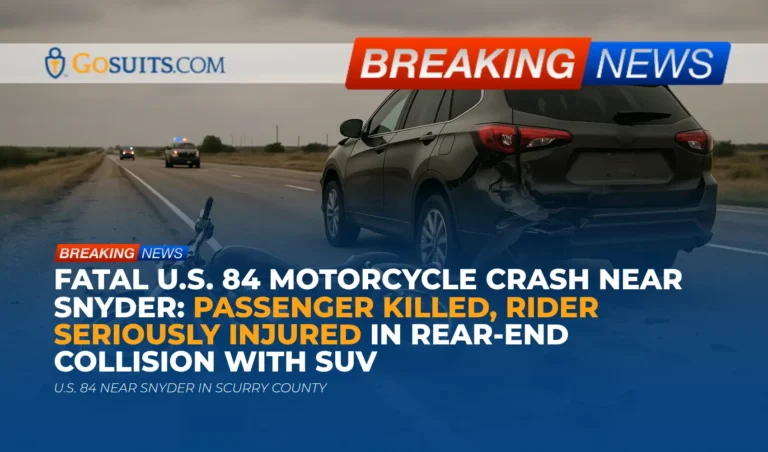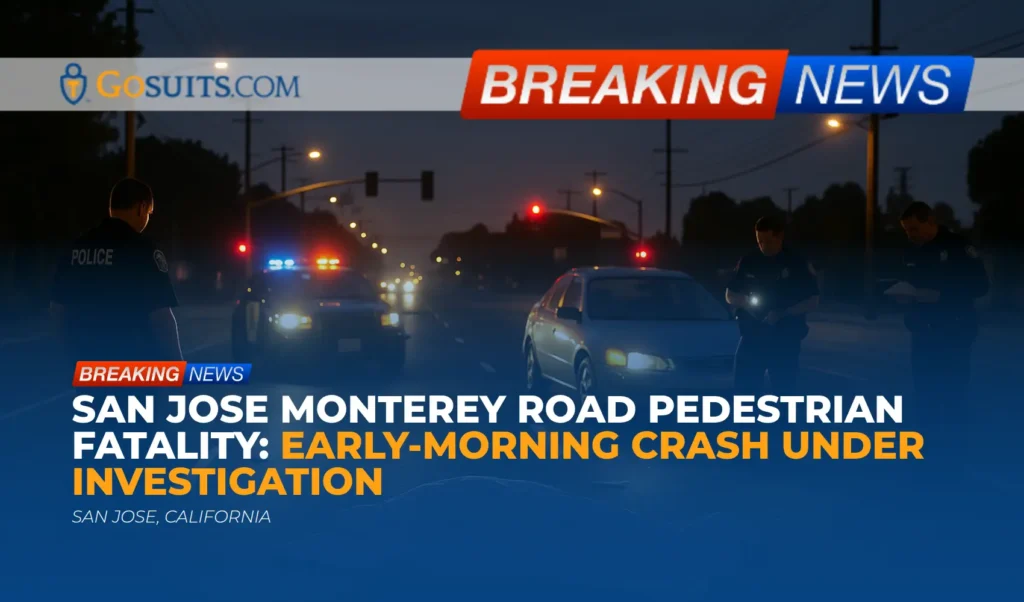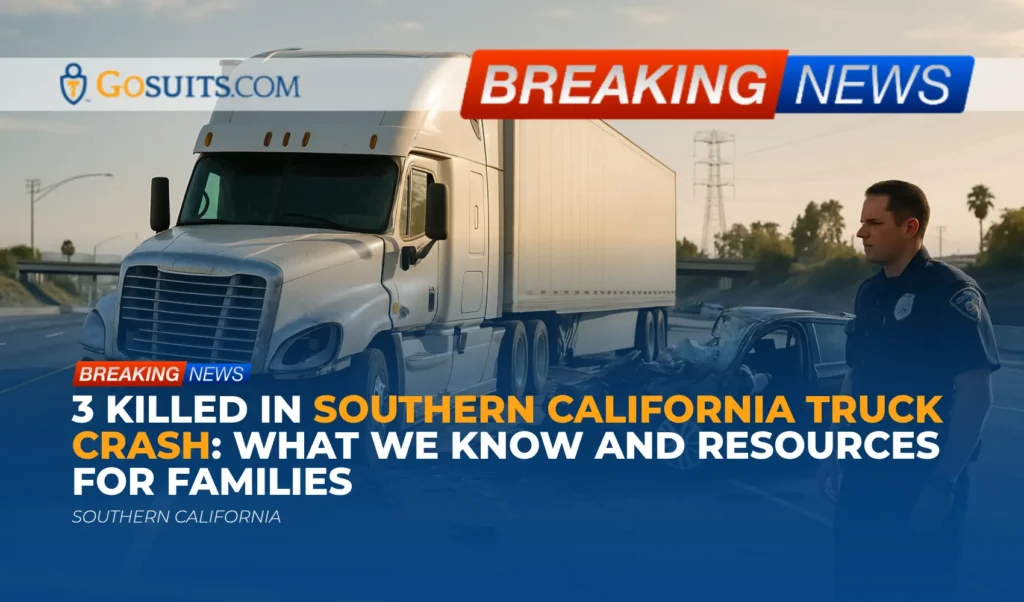- What we know about the U.S. 84 motorcycle crash near Snyder
- Agencies involved and how to obtain official records
- Safety and roadway context relevant to rear-end motorcycle crashes
- Legal rights after a fatal motorcycle crash in Texas
- Potential civil liability considerations
- Insurance and compensation pathways in Texas
- Practical steps families can take now
- Data and prevention insights
- Commentary from Gosuits Snyder, Texas Personal Injury Attorney
- Why urgent action matters after a serious motorcycle crash in Scurry County
- Sources
What we know about the U.S. 84 motorcycle crash near Snyder
A serious motorcycle crash occurred Thursday afternoon near Snyder in Scurry County on U.S. 84. According to a preliminary statement cited in local reporting, a 55-year-old rider traveling northbound on U.S. 84 collided with an SUV that had just entered the highway from Ennis Creek Road and was in the left lane. Investigators indicated the motorcycle did not maintain appropriate speed and rear‑ended the SUV. The rider suffered serious injuries and was transported to a hospital in Lubbock. The motorcycle passenger, a 50-year-old woman, tragically died at the scene. The SUV driver was reportedly uninjured. Both the rider and passenger were wearing helmets at the time of the crash.
Preliminary findings can evolve as investigators collect roadway measurements, vehicle data, and witness statements. Final determinations about contributing factors are typically documented in the official crash report, which may be obtained through the State of Texas once it becomes available. Families often have questions in the immediate aftermath. The sections below outline where to find official records, what safety and legal principles may be relevant, and how to protect rights while grief and recovery are ongoing.
Agencies involved and how to obtain official records
Fatal and serious-injury crashes on U.S. highways in rural areas of Texas are commonly investigated by the Texas Department of Public Safety (DPS) Highway Patrol. Multiple offices and systems may hold records related to this incident. Here is a practical guide to the records that often matter most after a serious crash.
Crash report (CR-3) and how to request it
In Texas, the official crash report is generally filed using a CR‑3 form. These reports are centralized by the Texas Department of Transportation (TxDOT). Once filed and processed, eligible requestors can purchase a copy through TxDOT’s Crash Report Online Purchase System. You will need details such as the date, location, and persons involved to locate the correct report.
- Where to request: TxDOT’s Crash Records Information System (CRIS) portal at https://cris.dot.state.tx.us/public/Purchase/crashReportSearch
- What to know: Reports are not always immediately available. Processing can take days or weeks. If the system does not return a result, try again later or contact the investigating agency.
Crash reports often include diagrams, officer narratives, and contributing factor codes. They may also reference citations or testing performed. These documents can be very important for insurance claims and civil proceedings.
Texas Department of Public Safety (investigating agency)
For clarifications about the investigation or to identify the case number, families may contact DPS Highway Patrol. While DPS may not release all investigative materials during an open investigation, they can often confirm the report number, investigating office, and towing or vehicle storage information.
- Agency page: https://www.dps.texas.gov/section/highway-patrol
- What to ask: Case number, report status, and which wrecker service was used if a vehicle was towed.
Autopsy or inquest records in Texas
In Texas, death investigations following sudden or unexpected fatalities are handled by either a county Medical Examiner’s Office or a Justice of the Peace (JP) conducting an inquest, depending on the county. Scurry County does not publicly advertise a stand‑alone medical examiner office; in many rural counties, the JP oversees the inquest and, if needed, a contracted medical examiner performs the autopsy. Policies vary by county, but next of kin may request information when it becomes available. Relevant law governing inquests and medical examiners can be found in Chapter 49 of the Texas Code of Criminal Procedure.
- Texas inquest and medical examiner law: https://statutes.capitol.texas.gov/Docs/CR/htm/CR.49.htm
- Who to contact: The Scurry County Justice of the Peace office or the Sheriff’s Office can direct families to the proper point of contact for an inquest or autopsy report, if one is conducted.
Be prepared to show proof of next‑of‑kin status and a government‑issued ID when requesting sensitive records. Timelines for release vary and may depend on toxicology or other testing.
Death certificates
Certified death certificates are issued by the Texas Department of State Health Services (DSHS). Funeral homes often assist families with this process, but it is also possible to request records directly from the state.
- Texas DSHS Death Records: https://www.dshs.texas.gov/vital-statistics/death-records
- Why it matters: Death certificates are required for insurance claims, probate, and other legal and administrative matters.
Towing and vehicle release
If the motorcycle or SUV was towed from the scene, the investigating agency or dispatch can confirm the storage lot and release procedures. Photo documentation of the motorcycle before repairs can be crucial for later analysis. Avoid authorizing repairs or disposal until all needed inspections are complete.
Safety and roadway context relevant to rear-end motorcycle crashes
Rear-end collisions involving a motorcycle and a larger vehicle present unique risks. Even at moderate speeds, the difference in mass between a motorcycle and an SUV can lead to catastrophic outcomes for motorcyclists and passengers. Helmets meaningfully reduce the risk of severe head injury, but they cannot eliminate all trauma to the chest, abdomen, spine, or extremities.
Under Texas law, drivers must maintain an assured clear distance between themselves and the vehicle ahead so they can stop safely without colliding, given the speed of the vehicles and roadway conditions. This is often referred to as the “assured clear distance” or “following distance” rule.
- Assured clear distance statute: Texas Transportation Code § 545.062 directs drivers to maintain a prudent following distance to avoid colliding with the vehicle ahead, considering speed and traffic conditions. See https://statutes.capitol.texas.gov/Docs/TN/htm/TN.545.htm#545.062.
When a vehicle enters a highway from a side road, drivers must also ensure the movement can be made safely without disrupting vehicles already traveling on the highway. Intersections and highway entry points can create speed differentials, sight line issues, and complex traffic dynamics. Investigations often focus on visibility, lighting, signage, surface conditions, and whether each driver’s actions were reasonable under the circumstances.
Even with helmets, motorcycle passengers remain vulnerable. National safety research consistently shows that helmets reduce the risk of head injury and death, but the severity of a collision can still overwhelm even well-used protective gear. For families, it is important to remember that the presence of a helmet is not an admission of fault by any party; it is one factor among many investigated after a crash.
Legal rights after a fatal motorcycle crash in Texas
Texas law recognizes both wrongful death claims and survival claims following a fatal incident. These are distinct civil actions with different purposes and potential beneficiaries.
Wrongful death
Wrongful death claims are brought by certain family members for the losses they suffer due to a loved one’s death. In Texas, the surviving spouse, children, and parents may bring a wrongful death action. If they do not file within a specified period, the executor or administrator of the estate may file on behalf of the beneficiaries.
- Statute: Texas Civil Practice and Remedies Code Chapter 71 governs wrongful death. See https://statutes.capitol.texas.gov/Docs/CP/htm/CP.71.htm.
Damages can encompass both economic and non‑economic components recognized under Texas law. The statute also allows exemplary (punitive) damages in certain cases involving willful acts or gross negligence, though such findings require specific evidence and are not presumed.
Survival action
A survival claim belongs to the decedent’s estate and addresses damages the person could have claimed if they had survived, such as pain and suffering experienced between injury and death, medical expenses, and other losses. The estate’s representative brings the survival action, and any recovery becomes part of the estate for distribution under probate law.
- Statute: Texas Civil Practice and Remedies Code § 71.021. See https://statutes.capitol.texas.gov/Docs/CP/htm/CP.71.htm#71.021.
Comparative responsibility
Texas follows a modified comparative responsibility rule for civil cases. A claimant’s recovery can be reduced by their percentage of responsibility. If a claimant is found to be more than 50 percent responsible, they are barred from recovery. In multi‑party crashes, responsibility can be divided among multiple individuals or entities based on the evidence.
- Statute: Texas Civil Practice and Remedies Code Chapter 33. See https://statutes.capitol.texas.gov/Docs/CP/htm/CP.33.htm.
Preliminary crash summaries do not control civil fault determinations. Independent analysis of physical evidence, data, and testimony is often necessary before assigning responsibility.

Statute of limitations
Most Texas wrongful death and personal injury claims must be filed within two years of the date of the incident, subject to limited exceptions. Time can pass quickly while investigations unfold, so understanding deadlines early is important.
- Statute: Texas Civil Practice and Remedies Code § 16.003. See https://statutes.capitol.texas.gov/Docs/CP/htm/CP.16.htm#16.003.
Potential civil liability considerations
Every crash is unique. The points below highlight common civil issues investigators and attorneys consider in a highway rear‑end collision involving a motorcycle and a larger vehicle. These are general factors, not conclusions about this particular incident.
- Following distance and speed control: Evidence about the motorcycle’s speed, perception‑reaction time, braking, and skid marks can inform whether there was a sufficient assured clear distance given the SUV’s entry and position in the lane.
- Highway entry from a side road: When a vehicle enters or crosses a highway, investigators evaluate sight distances, signage, lighting, and whether the maneuver could be completed safely without creating an unreasonable hazard. The exact timing of movements can be critical.
- Vehicle data and cameras: Many late‑model SUVs contain an event data recorder (EDR) that may capture pre‑impact speed, braking, and throttle position. Third‑party dashcams, nearby business cameras, and traffic cameras may also provide helpful footage. See NHTSA’s overview of EDRs at https://www.nhtsa.gov/research-data/event-data-recorder.
- Motorcycle condition: Brake condition, tire wear, and any aftermarket equipment can matter. Preserving the motorcycle for inspection helps ensure a complete analysis.
- Roadway conditions: Debris, oil, water, sun glare, and pavement condition can contribute. In rare cases, roadway design or maintenance issues may be examined, though claims against governmental entities have special notice and immunity rules.
- Helmet and protective gear: Helmet use is legally relevant in Texas primarily to compliance and injury mitigation, not to decide who caused a collision. Helmets can reduce the severity of injuries but cannot prevent all harm.
- Witness accounts and 911 records: Independent witnesses, timing of calls, and radio logs can help reconstruct the sequence of events.
When multiple factors are in play, preserving evidence quickly is important. A written preservation request, sometimes called a “spoliation letter,” can ask involved parties to retain vehicle data, dashcam footage, cell phone records, and relevant maintenance logs.
Insurance and compensation pathways in Texas
Understanding available insurance coverage helps families plan for immediate expenses and long‑term needs. Texas requires drivers to carry minimum liability coverage and insurers must offer certain additional coverages that can be accepted or declined in writing.
Texas minimum liability coverage
Texas law requires minimum auto liability coverage of 30/60/25: $30,000 bodily injury per person, $60,000 per crash, and $25,000 property damage per crash. These limits are the minimum; many drivers carry higher limits. Liability coverage pays for injuries and damage the policyholder causes to others, subject to investigation and proof. See the Texas Department of Insurance’s consumer guide at https://www.tdi.texas.gov/pubs/consumer/cb020.html.
Personal Injury Protection (PIP) and Medical Payments
In Texas, insurers must offer Personal Injury Protection (PIP), which can help with medical bills and certain lost wages regardless of fault. Policyholders may reject PIP in writing. Medical Payments (MedPay) coverage is also available in Texas and helps with medical costs but typically does not cover lost wages. The availability and limits depend on the policy. See the Texas Department of Insurance consumer materials at https://www.tdi.texas.gov/pubs/consumer/cb020.html.
Uninsured/Underinsured Motorist (UM/UIM)
UM/UIM coverage is also required to be offered and can be rejected in writing. It can apply when an at‑fault driver has no insurance or insufficient limits. The precise application depends on the facts and policy language. See https://www.tdi.texas.gov/pubs/consumer/cb020.html.
Motorcycle helmets and Texas law
Texas Transportation Code Chapter 661 addresses motorcycle helmets. Adult riders meeting certain criteria may ride without a helmet, but helmet use remains a proven safety measure. For the legal framework, see https://statutes.capitol.texas.gov/Docs/TN/htm/TN.661.htm.
If an insurance company contacts you
Insurance adjusters often seek recorded statements early. What someone says can be used later, sometimes out of context. Before giving any statement, it is prudent to speak with a seasoned attorney who can explain rights and help avoid common pitfalls. If a claim is necessary, counsel can communicate with insurers, review coverages, and protect against premature settlements that do not reflect the full scope of loss.
Practical steps families can take now
After a severe crash and a devastating loss, tasks can feel overwhelming. The steps below can help keep options open while honoring immediate needs.
- Request official records promptly: Start with the TxDOT crash report via CRIS. Ask DPS for the case number. Obtain the death certificate through DSHS. Keep a file with all documents, letters, and receipts.
- Preserve evidence: Do not authorize repair or disposal of the motorcycle or helmet until any needed inspections are complete. Save all photographs, clothing, and gear. Ask that the SUV’s EDR data be preserved. Request nearby businesses to hold any exterior camera footage that may have captured the crash or traffic conditions.
- Document expenses and losses: Keep records of medical bills, funeral and burial expenses, travel for medical care, and time missed from work. Maintain a diary of health updates, pain levels, and the impact on daily life for the injured rider.
- Coordinate with healthcare providers: Ask for discharge summaries, imaging reports, and treatment plans for the injured rider. Confirm that all providers have the correct billing information and file claims to avoid interruptions in care.
- Be cautious with insurance communications: If an adjuster calls, write down their name, company, and claim number, and let them know you prefer to speak after consulting an attorney. Recorded statements can be used later. A consultation can help clarify what to share and when.
- Notify life and health insurers: Life insurance carriers typically require a death certificate; some may request additional documentation. Health insurers can explain coverage for trauma care and any subrogation rights, which means they may seek repayment from any recovery.
- Consider probate steps: If a survival claim or estate administration becomes necessary, the family may need to open a probate case so a representative can act on the estate’s behalf. Probate is separate from the crash investigation and can take time.
- Care for emotional well‑being: Sudden loss and severe injuries are traumatic. Regional hospitals, faith communities, and local counseling providers can support grief and recovery. Taking time to lean on community resources is not only okay—it is necessary.
Data and prevention insights
While no statistic eases the pain of a single family, understanding risk can inform safer choices and community advocacy.
- Helmet effectiveness: National health and safety agencies report that helmets substantially reduce the risk of death and head injury for motorcyclists and passengers. The Centers for Disease Control and Prevention notes that helmet use reduces the risk of head injury by about 69 percent and the risk of death by about 37 percent. See https://www.cdc.gov/motorvehiclesafety/mc/index.html.
- Motorcyclist fatalities at a glance: NHTSA’s Traffic Safety Facts reports that motorcyclist fatalities have remained elevated in recent years nationwide. See NHTSA’s motorcycle safety page at https://www.nhtsa.gov/road-safety/motorcycles for current data summaries.
- Texas highway safety efforts: TxDOT’s motorcycle safety campaign emphasizes shared responsibility—drivers looking twice for motorcyclists and riders using high‑visibility gear and lane positioning. See https://www.txdot.gov/safety/traffic-safety-campaigns/motorcycle-safety.html.
For drivers, extra caution is warranted when entering high‑speed highways from side roads or driveways. Judging the speed of an approaching motorcycle can be difficult due to its smaller size and profile. For riders, maintaining a cushion of space, scanning far ahead, and anticipating vehicles entering from side roads remain vital defensive strategies. These measures do not eliminate risk, but they can improve reaction time when the unexpected happens.

Commentary from Gosuits Snyder, Texas Personal Injury Attorney
Our hearts go out to everyone affected by the crash on U.S. 84 near Snyder. A passenger’s death and a rider’s serious injuries are profound losses for family and friends. This discussion is offered for educational purposes and general information during a difficult time.
Based on the preliminary information, investigators are examining a rear‑end collision sequence after an SUV entered the highway. In Texas civil cases, responsibility is rarely determined by a single factor. The assured clear distance rule, the timing of the SUV’s entry, sight lines from Ennis Creek Road, and vehicle speeds may all be considered. Event data from the SUV, physical evidence from the roadway, and any available camera footage could clarify the sequence and timing. It is important not to treat early summaries as final conclusions; comprehensive analysis often paints a fuller picture.
Insurance companies and corporate defendants typically move quickly to collect statements and secure documents. They may seek recorded interviews before families understand the full scope of injuries, grief, and financial impact. Statements given early can be used later and may not reflect new information that emerges. Policy terms for liability, PIP, UM/UIM, and health insurance can be difficult to navigate while dealing with loss and recovery. A free consultation with a seasoned attorney can help families understand their rights, identify timelines, and avoid common pitfalls, including premature settlements that do not account for long‑term needs.
Why urgent action matters after a serious motorcycle crash in Scurry County
Taking timely steps after a catastrophic crash preserves options and protects the integrity of evidence. The following actions are important, and delaying them can make a meaningful difference in outcomes:
- Secure official reports and records: Crash reports, inquest records, and death certificates form the backbone of many insurance and legal processes. Obtaining them early helps ensure claims are complete and deadlines are met.
- Preserve evidence before it disappears: Skid marks fade, vehicles are repaired or salvaged, and camera footage is overwritten—sometimes within days. A prompt request to preserve vehicle data, surveillance video, and physical evidence can prevent critical information from being lost.
- Clarify insurance benefits and deadlines: Policy notice requirements and time limits can apply to PIP, UM/UIM, and liability claims. Understanding what coverage may apply helps families plan for medical care, income disruption, and funeral expenses.
- Avoid recorded statements before guidance: Early statements carry consequences. Waiting until knowledgeable counsel explains rights and options reduces the risk of misunderstandings that could undermine a valid claim later.
- Plan for long‑term needs: Serious injuries may involve surgeries, rehabilitation, mobility equipment, and home adjustments. Identifying resources early helps ensure continuity of care and reduces financial strain.
- Track all losses and communications: Keeping a centralized file of medical records, bills, and correspondence simplifies the process and helps avoid missed details when decisions are time‑sensitive.
Acting promptly is not about rushing during grief; it is about protecting choices and ensuring that important evidence and benefits do not slip away with time.
Sources
- TxDOT Crash Report Purchase System (CRIS): https://cris.dot.state.tx.us/public/Purchase/crashReportSearch
- Texas DPS Highway Patrol: https://www.dps.texas.gov/section/highway-patrol
- Texas Code of Criminal Procedure, Chapter 49 (Inquests; Medical Examiners): https://statutes.capitol.texas.gov/Docs/CR/htm/CR.49.htm
- Texas DSHS Death Records: https://www.dshs.texas.gov/vital-statistics/death-records
- Texas Transportation Code § 545.062 (Following distance): https://statutes.capitol.texas.gov/Docs/TN/htm/TN.545.htm#545.062
- Texas Transportation Code, Chapter 661 (Motorcycle Helmets): https://statutes.capitol.texas.gov/Docs/TN/htm/TN.661.htm
- Texas Civil Practice and Remedies Code, Chapter 71 (Wrongful Death and Survival): https://statutes.capitol.texas.gov/Docs/CP/htm/CP.71.htm
- Texas Civil Practice and Remedies Code § 16.003 (Two‑year limitations): https://statutes.capitol.texas.gov/Docs/CP/htm/CP.16.htm#16.003
- Texas Civil Practice and Remedies Code, Chapter 33 (Proportionate Responsibility): https://statutes.capitol.texas.gov/Docs/CP/htm/CP.33.htm
- Texas Department of Insurance, Auto Insurance Consumer Guide (PIP, UM/UIM, minimum limits): https://www.tdi.texas.gov/pubs/consumer/cb020.html
- CDC, Motorcycle Safety (helmet effectiveness): https://www.cdc.gov/motorvehiclesafety/mc/index.html
- NHTSA, Motorcycle Safety: https://www.nhtsa.gov/road-safety/motorcycles
- NHTSA, Event Data Recorder (EDR) information: https://www.nhtsa.gov/research-data/event-data-recorder
- TxDOT, Motorcycle Safety Campaign: https://www.txdot.gov/safety/traffic-safety-campaigns/motorcycle-safety.html






